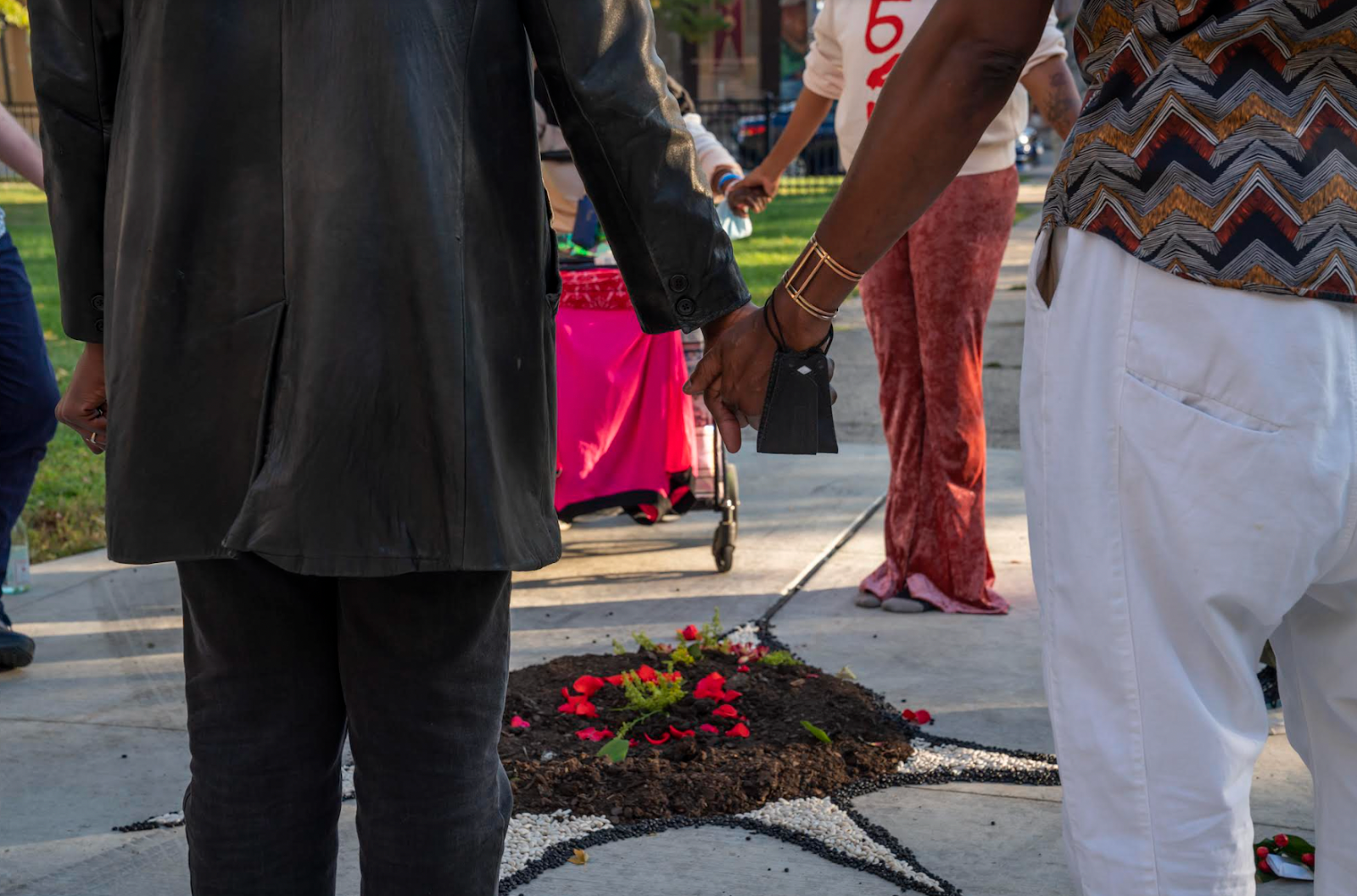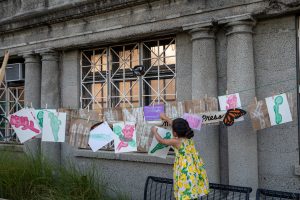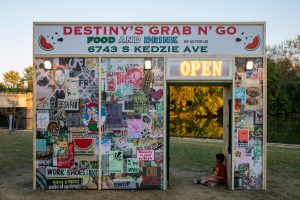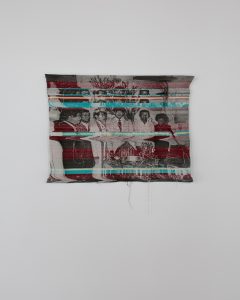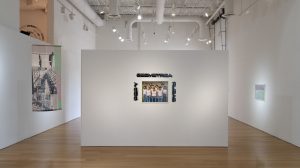This article was developed and written as part of Muña, an art writing program providing a cohort of six writers the opportunity to critically and creatively engage with art writing strategies, readings, exercises, and conversations. The program is structured for writers to develop and refine their practices through guided workshops and peer-review feedback. Its task is to stir, incubate, and pollinate shared consciousness on holistic, equitable, and attentive art writing and language practices. Muña is a program collaboration by Chuquimarca and Sixty Inches From Center.

Para leer este artículo en Español, presione aqui.
It was a cool, Autumn night when I reached Austin Town Hall Park. To my dismay, the Cultural Center building was closed for the day so I was not able to access the indoor exhibition space. That made the exhibition that much more riveting as all the work I saw was outside. As I was leaving, I stumbled upon Tiffany Johnson fixing JaMaa Gee’s Untitled piece that the wind had knocked down the night prior. We talked about the importance of care and what it looks like when you live next to a living exhibition that you can check up on. But also, the way the community had taken into caring for the works as well. What does art for the community look like? How can we reshape and create healthier modes for artists to give back to the communities around Chicago?
“I stumbled upon Tiffany Johnson fixing JaMaa Gee’s Untitled piece that the wind had knocked down the night prior. We talked about the importance of care and what it looks like when you live next to a living exhibition that you can check up on.”
Finding Ceremony is an exhibition curated by Tiffany Johnson. The exhibition includes work by Janelle Ayana Miller, Kenya Cree, Eseosa Edebiri, Tavia David, Cai Thomas, Antonia “Toni” Ruppert, JaMaa, Alexy Irving, Edna M. Togba, and the Black Bloom Project which is composed of Jade Williams and Cristabel Reynosa-Martinez. Johnson was the first curatorial resident to participate in the Anchor Curatorial Residency. This curatorial residency facilitates exploration of collective ways of being on the neighborhood level and challenges artists to rethink what public art looks like and means. Taking place over the course of a year, the residency moves away from traditional art spaces, and focuses on Cultural Centers in the Chicago Park Districts.
Through conversations and meetings with the Austin community, Johnson and community members worked together to create a show that fostered the already existing aspects of the West side. Together they organized a food market with Forty Acres Fresh Market that happened every Thursday included DJ performance to bring more folks in. In addition to the DJ, vouchers were also handed out for community members to shop for food. Aside from the outdoor exhibition, Johnson also collaborated with designer Walmer Saavedra of Human Scale and fabricated by Andrea Yarbrough of In Care of Black Women to create a performance venue that can be used by the surrounding community. Through a collective activation of the space, Johnson wanted to emphasize the importance of the local community in order to explore ways of “…finding, recharting and reclaiming Black and Brown relations to public spaces and each other.”
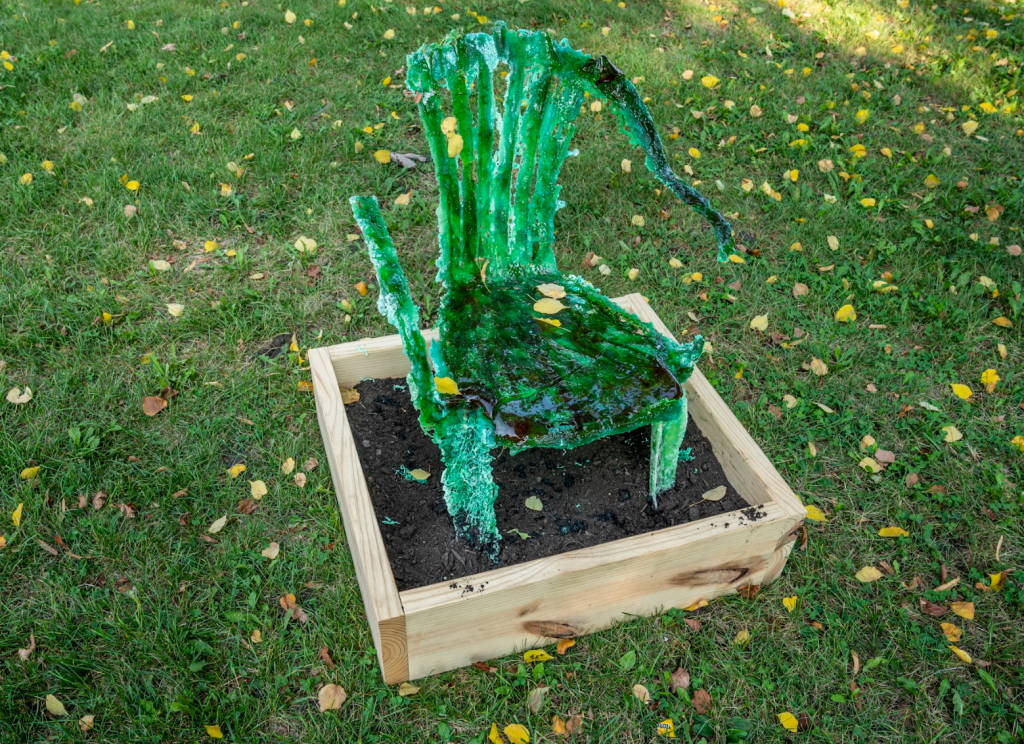
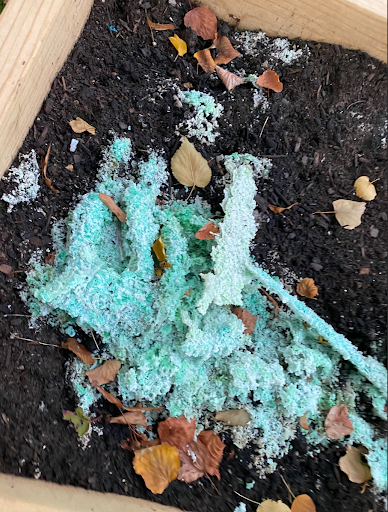
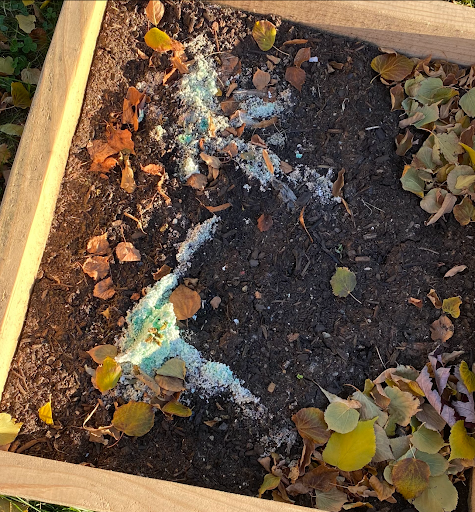
Something to take into account for outdoor art exhibitions is the ways the works change over time. Whether it is from natural occurring effects by nature or man-made alterations, there will be some change from the original iteration. This can be seen with Candy Houses by Tavia David, which is the first piece I encountered when I entered Austin Town Hall Park. It is made of isomalt, water food coloring, and flavor additives and resembles a green chair. Over time, it is intentionally meant to naturally decompose due to the weather and insects that take pieces with them. Janelle Ayana Miller takes into account the possibility of erosion and laminates photographs in order to further archive them. Miller’s piece…and it came like a vision in the night (dreaming delta blues from refuge to you), is made of wood, steel, wire, resin, and brass. The tamborines hanging from beaded wire connected to a wooden structure interact with the wind throughout the day. Edna M. Togba takes an installation approach and creates an elevated garden that feels like an alter. Togba’s Tending to My Garden, is made of wood, plants, natural materials, as well as mirrors, and hidden gems throughout such as images on wooden panels. This garden was dealing more with the latter of changes pertaining to man-made alterations. On various days, Togba would replenish any of the materials that were open for the taken by community members, as well as light sage.
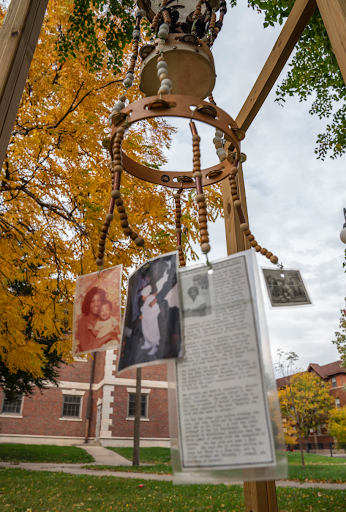
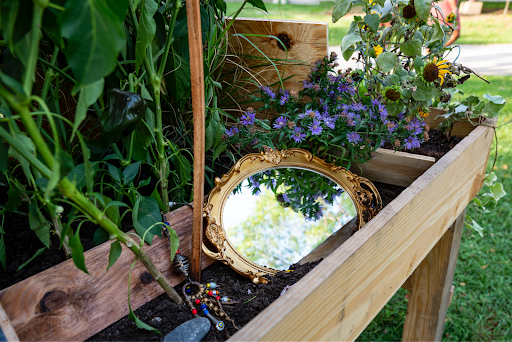
Kenya Cree made a ceramic called Saving lil bit of yourself, 2022. This was positioned closer to the cultural center building and showcased two heads on a wooden platform. The one on the bottom was much larger. Both had dried blue paint dripping down. Eseosa Edebiri’s piece May the Flowers You Sow Grow, 2021 is made of punch needle embroidery, wood, and wire. It is a wooden square with the embroidery covering up all the wood in shades of greens and pink and yellow flowers. The greens mimic the surrounding greenery of the park. The title of the piece is embroidered in the middle of the wood panel in bright pink lettering. This piece was hung high on a tree in the park. I saw a few squirrels trying to interact with the piece and taking bits for themselves. Jamaa Gee’s installation Untitled, 2022 was a painting made of acrylic, marker, and paste. It was held by a wooden structure and by black sand bags. Black Bloom Project’s members Jade Williams and Cristabel Reynosa-Martinez created Earthen, 2022 made of light and possibilities. This piece is a stained glass, wooden arch that acts as a portal for to be explored and walked through.
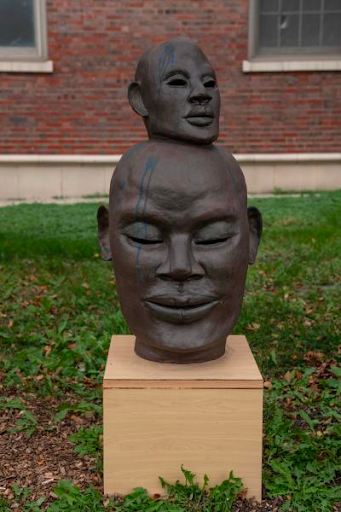
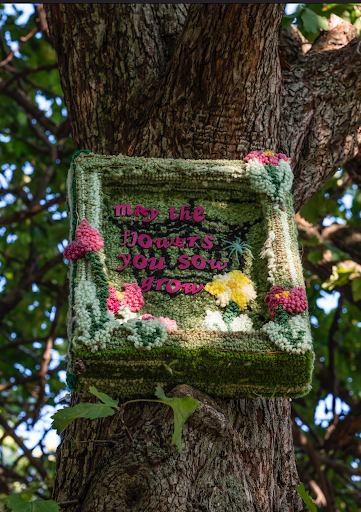
Image: (Left to Right) Kenya Cree’s Saving lil bit of yourself, 2022. Eseosa Edebiri’s piece May the Flowers You Sow Grow, 2021. Photo credits: Tiffany Johnson, 2022.
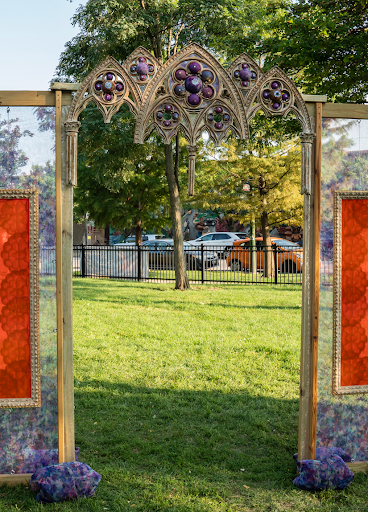
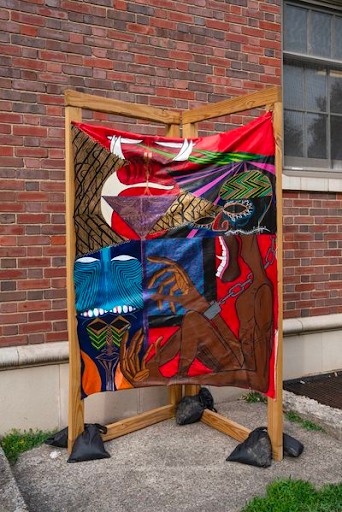
Image: (Left to Right) Black Bloom Project’s (Jade Williams and Cristabel Reynosa-Martinez) Earthen, 2022. Jamaa Gee’s Untitled, 2022. Photo credits: Tiffany Johnson, 2022.
The remaining artists had works in the cultural center for a transitional exhibition. Cai Thomas in collaboration with Omar Elane Jr., Jamilah Hobbs, Nuree Kim, and Bianca Jones created a film titled Change The Name, 2022. The film talks about Black youth organizing on the west side of Chicago, more specifically from Village Leadership Academy successful efforts to rename Stephen A. Douglas Park after freedom fighters Anna and Frederick Douglass. Antonia “Toni” Ruppert, has a series of watercolor works on paper ranging in size titled, Series I: Among the Greens I, II & III, Series II: Grace Among the Trees, and Past Reflections, 2022. The first three are faces in splashes of bright blue, red, and teal. Alexy Irving has three framed photographs titled Generational Wealth, Strength & Love in Full Bloom, 2022.
“Both the community and artists had to learn and unlearn what they are used to in terms of exhibiting and viewing art. Through this process, trust was established.”
Each artist is talking about their connections to the South and West sides of Chicago and how they relate to public space. What does it mean to leave your artwork in spaces that are outdoors and unguarded unlike in galleries and museum spaces? All the artists experienced this challenge but achieved as a collective. Through means of sharing and being one with the surrounding community, they fostered relationships along with Johnson, to the point where community members would check in on the artworks. Providing care on both ends to one another but also to the artworks which were made and displayed for the surrounding community to indulge in. The concept of not needing to guard works for both the artists and the community since they can view and take in art without feeling like they would in a gallery or museum. Often, works in galleries and museums are behind glass and blocked off by tape keeping people away from them. This surveillance was not noted here which allowed public access for folks to take in the works that are not limiting. Both the community and artists had to learn and unlearn what they are used to in terms of exhibiting and viewing art. Through this process, trust was established. Art was not placed in the Austin neighborhood as an end all be all but instead as a collaborative endeavor that fostered care. Art for the community can look like this. An outdoor exhibition where folks can freely interact with artworks! This is a step in reshaping and creating healthier modes for both artists and community to rely on one another through art in a non-transactional way.
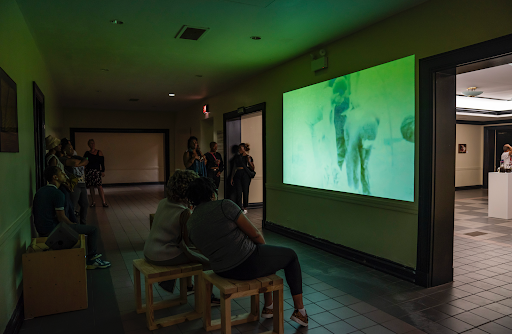
Tensions feel so heavy here,
but there’s also an array
Array of hope reflecting in the sun’s rays
Hold onto it and tuck it away
for a rainy day
Lead me to the sorrows
Worry not, as there is more to this by
the very beings that held us together
I saw you enchanted by the gates
Joy carried a ride on the backs of the bees
The visions of your futures were
placed onto seeds by your realistic imaginary
Fruits and vegetables were dancing and
Glistening droplets paraded while
the music played on
-Cristobal Alday
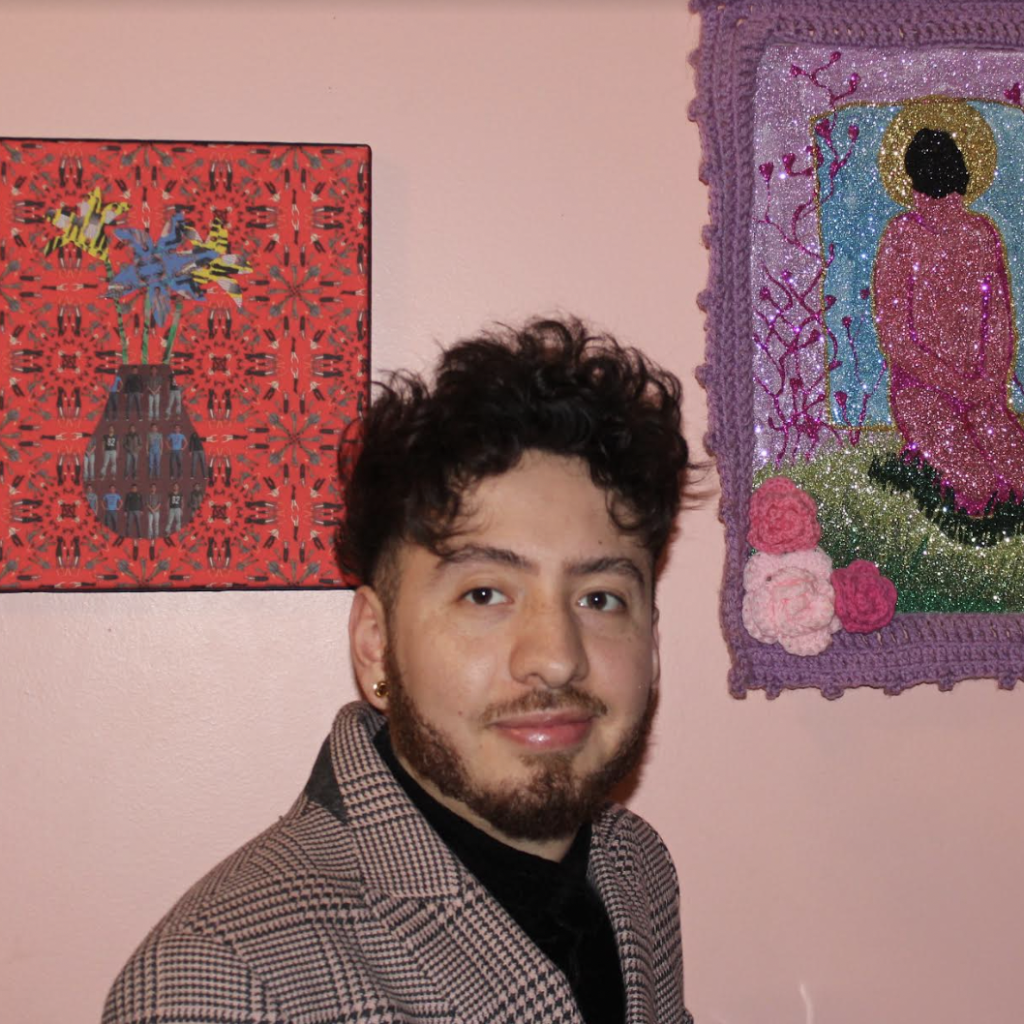
About the Author: Cristobal Alday (he/him) is a Queer Latinx creative from the south side of Chicago. He focuses on photography, and film particularly dealing with queerness, familial dynamics, and space. He is an independent curator currently utilizing his room to curate exhibitions with works by local artists. His artistic practice influences his curatorial and writing approaches. Using collage making and poetic responses, he reflects on artists, their works and exhibitions and focuses on the collaborative aspect of projects and art making through audience interaction via online platforms and in person. Utilizing archival family photographs and influences from around the city, he creates a form of communicating history of the past, present and what could be the future. He has held previous positions at the Art Institute of Chicago-Prints and Drawings Department, Block Museum of Art, Northwestern University: Art Theory and Practice Department, National Museum of Mexican Art, Chicago Artists Coalition, and Johalla Projects. Exhibited at Fundación Universidad del Cine (Universidad del Cine), Buenos Aires, Argentina; Fulton Street Collective, Chicago Illinois; and the Chicago Artists Coalition.
